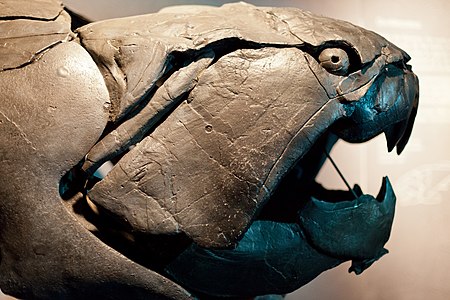User:Abyssal/Portal:Devonian
IntroductionThe Devonian (/dəˈvoʊni.ən, dɛ-/ də-VOH-nee-ən, deh-) is a geologic period and system of the Paleozoic era during the Phanerozoic eon, spanning 60.3 million years from the end of the preceding Silurian period at 419.2 million years ago (Ma), to the beginning of the succeeding Carboniferous period at 358.9 Ma. It is the fourth period of both the Paleozoic and the Phanerozoic. It is named after Devon, South West England, where rocks from this period were first studied. The first significant evolutionary radiation of life on land occurred during the Devonian, as free-sporing land plants (pteridophytes) began to spread across dry land, forming extensive coal forests which covered the continents. By the middle of the Devonian, several groups of vascular plants had evolved leaves and true roots, and by the end of the period the first seed-bearing plants (pteridospermatophytes) appeared. This rapid evolution and colonization process, which had begun during the Silurian, is known as the Silurian-Devonian Terrestrial Revolution. The earliest land animals, predominantly arthropods such as myriapods, arachnids and hexapods, also became well-established early in this period, after beginning their colonization of land at least from the Ordovician period. (Full article...) Selected article on the Devonian world and its legacies
Insects are a class of invertebrates within the arthropod phylum that have a chitinous exoskeleton, a three-part body (head, thorax and abdomen), three pairs of jointed legs, compound eyes and one pair of antennae. They are among the most diverse groups of animals on the planet, including more than a million described species and representing more than half of all known living organisms. Insects may be found in nearly all environments, although only a small number of species reside in the oceans.
The life cycles of insects vary but most insects hatch from eggs. Insect growth is constrained by the inelastic exoskeleton and development involves a series of molts. The immature stages can differ from the adults in structure, habit and habitat. Insects that undergoincomplete metamorphosis lack a pupal stage and adults develop through a series of nymphal stages. Fossilized insects of enormous size have been found from the Paleozoic Era, including giant dragonflies with wingspans of 55 to 70 cm (22–28 in). The most diverse insect groups appear to have coevolved with flowering plants. Adult insects typically move about by walking, flying, or sometimes swimming. Insects are the only invertebrates to have evolved flight. Many insects spend at least part of their lives under water, with larval adaptations that include gills, and some adult insects are aquatic and have adaptations for swimming. Insects are mostly solitary, but some, such as certain bees, ants and termites, are social and live in large, well-organized colonies. (see more...) Did you know?
Need help?Do you have a question about Abyssal/Portal:Devonian that you can't find the answer to? Consider asking it at the Wikipedia reference desk. Selected image
Selected article on the Devonian in human science, culture and economics
Paleontology or palaeontology (/ˌpeɪliɒnˈtɒlədʒi, ˌpæli-, -ən-/) is the scientific study of prehistoric life. It includes the study of fossils to determine organisms' evolution and interactions with each other and their environments (their paleoecology). As a "historical science" it attempts to explain causes rather than conduct experiments to observe effects. Paleontological observations have been documented as far back as the 5th century BC. The science became established in the 18th century as a result of Georges Cuvier's work on comparative anatomy, and developed rapidly in the 19th century. The term itself originates from Greek: παλαιός (palaios) meaning "old, ancient," ὄν, ὀντ- (on, ont-), meaning "being, creature" and λόγος (logos), meaning "speech, thought, study".
Paleontology lies on the border between biology and geology. It now uses techniques drawn from a wide range of sciences, including biochemistry, mathematics and engineering. Use of all these techniques has enabled paleontologists to discover much of the evolutionary history of life, almost all the way back to when Earth became capable of supporting life, about 3,800 million years ago. As knowledge has increased, paleontology has developed specialized sub-divisions, some of which focus on different types of fossil organisms while others study ecology and environmental history, such as ancient climates. Body fossils and trace fossils are the principal types of evidence about ancient life, and geochemical evidence has helped to decipher the evolution of life before there were organisms large enough to leave fossils. (see more...) GeochronologyEpochs - Early Devonian - Middle Devonian - Late Devonian Landmasses - Baltica - Laurentia - Euramerica - Gondwana Fossil sites - Grenfell fossil site History - The Great Devonian Controversy SubcategoriesQuality ContentFeatured Devonian articles - None Things you can doRelated contentAssociated WikimediaThe following Wikimedia Foundation sister projects provide more on this subject:
|






















